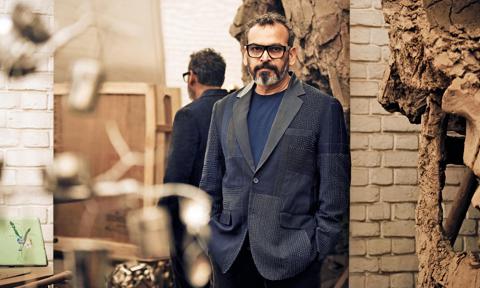
Why he matters: He’s among India’s most gifted conceptual artists, with a special fondness for stainless steel. But what fuels his imagination? Nostalgia, memories, faith, an intense Bihari-ness and freely available Indian motifs, suggests Shaikh Ayaz.
One of the undisputed joys of encountering Subodh Gupta’s art — or sculptural landscapes, as one scholar dubbed it — is how monumental and mechanical it appears on the surface while being deeply personal and intimate at its core. There’s no need to belabour his fondness for stainless steel, an ordinary material he’s transformed into readymades of Duchampian proportions over the last three decades.
Hailing from a tiny village in Bihar and raised in a family of railway employees, Gupta likes to refer to himself as a “railway boy,” though it wouldn’t be wrong to crown him as the great Indian “kitchen boy.” Playful, nostalgic, experimental and, in many ways, universal, his shiny sculptures based on the ubiquitous Indian utensils may now seem cliché because art lovers, particularly in India, have grown so familiar with Gupta’s wholehearted celebration—and occasional subversion—of our culture.
Yet, “cliché” is just another word for “classic,” and his recurring motif of cooking objects often has a layered meaning that invites us to contemplate the ideas of beauty, poverty, nostalgia, consumerism, identity, rituals, myths, spirituality and, increasingly, the mysteries of the cosmos.
If there’s larger-than-life drama and spectacle in Gupta’s work, it’s perhaps due to his lifelong interest in theatre. Acting and not painting, it seems, was his first love. A former street theatre artist, he once mused, “Whenever I exhibit large art installations, it’s, for me, a performance. My work is performing by itself.”
Indeed, Gupta’s extraordinary journey from a struggling artist in the Indian art world to one of its major figures today reads like a plot of a Hindi movie from the 1970s. Speaking to him last year during an interview, I urged him to reflect on his life and career. He sounded in awe of his own good luck, insisting that just becoming an artist was a “dream come true” moment. Success, it appears, was never even on his mind.
Born in Khagaul, Gupta took up art at the Patna College of Arts and Crafts in the mid 1980s. One story goes that he was offered a job at a newspaper, but recommended it to a flatmate because he wanted to move to Delhi. Immediately, his innate Bihari-ness was put to test in the city—even as he soon realised that the term “Bihari” was not an abuse but something to be proud of.
He responded to the dilemma by doing what he does best: in 1999, he produced an early-career work, titled Bihari, fashioned out of cow dung, among other materials, featuring the word “Bihari” at the bottom, blinking unabashedly in neon to remind viewers that he is one. What’s a performance if that wasn’t one? In fact, he also bathed himself in cow dung for an experimental video!
And then, Gupta discovered steel utensils, and the rest is history. From large-scale metallic huts to skulls (one famous specimen adorns French billionaire François Pinault’s collection) and even a life-sized tree, Gupta has conjured up epic visuals with the humble steel.
The story of Subodh Gupta, now 59, is also the story of globalisation in India. His rise from a humble rural background to the upper echelons of art is exactly what the “Indian Dream” is made of. Which is why the utensils he uses are symbolic of the middle-class and their hopes, dreams and struggles.
What gives Gupta’s sculptures further meaning is that they are infused with his personal memories, about his mother, his village (a show at France’s Galleria Continua last year was entirely about his roots), his faith and the search for his own place in the world. Even as his expensive works find widespread resonance in the West, they exude the rooted allure of Kabir and Premchand. In Subodh Gupta’s case, local is truly global.
To see who else is on the list, grab the copy of HELLO! India’s August 2023 issue right here!
- Quick links
- HELLO! 100 Most Influential
- artist






